The DMX-40 Morse Code Transceiver from PreppComm has the ability to get you on the air operating CW before you know a single character of Morse code. It accomplishes this with its built-in ability to decode Morse code without the need for any additional hardware or computer. It also lets you encode by simply typing your message on the included USB keyboard. The DMX-40 was designed in Sandpoint, Idaho by Eric Anderson, callsign AF7YQ.
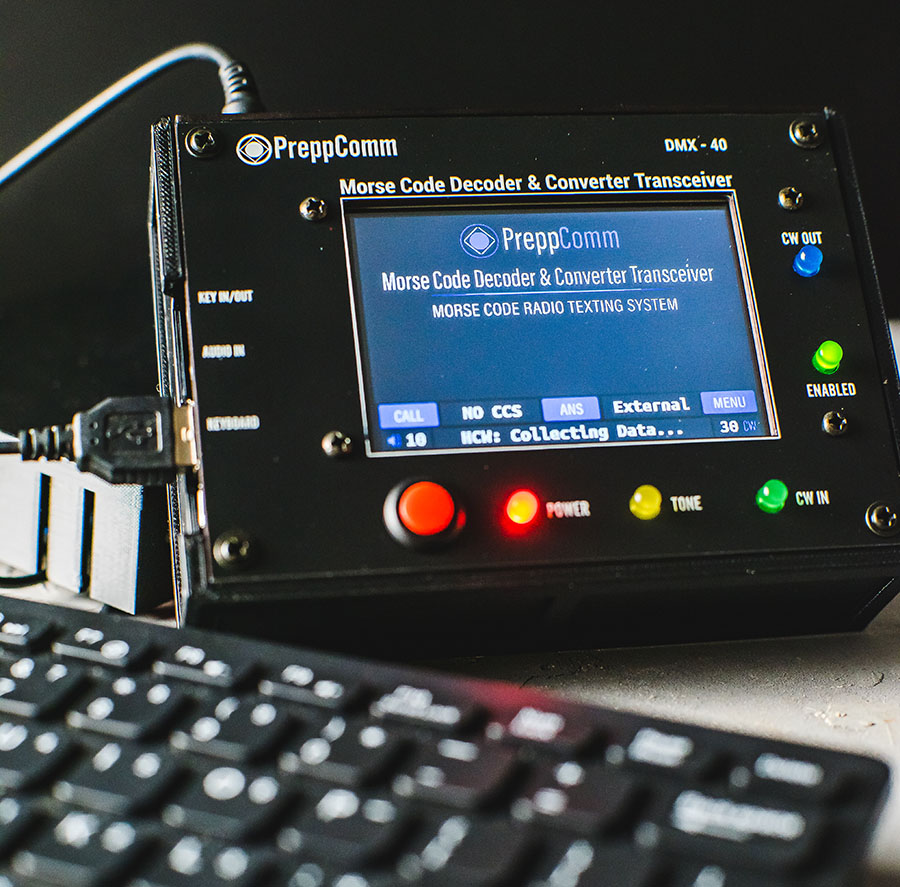
For decades, CW communication usage has been in a constant state of decline when compared to other modes and the quantity of licensed hams. This topic is highly debated but many hams agree that it’s in part due to the introduction of AM/SSB voice communication modes as well as the removal of the Morse code test requirement. Most will also attribute it to the steady increase in popularity of digital modes such as the infamous FT8.
Learning morse code can be an ominous task that deters many hams from even making the attempt. Non-retired ham radio operators may be very interested but have little time for CW practice between work and taking care of the family. For many hams with limited time to play ham radio it’s a tough call between the arduous task of studying CW or immense fun of actually playing ham radio on the air.
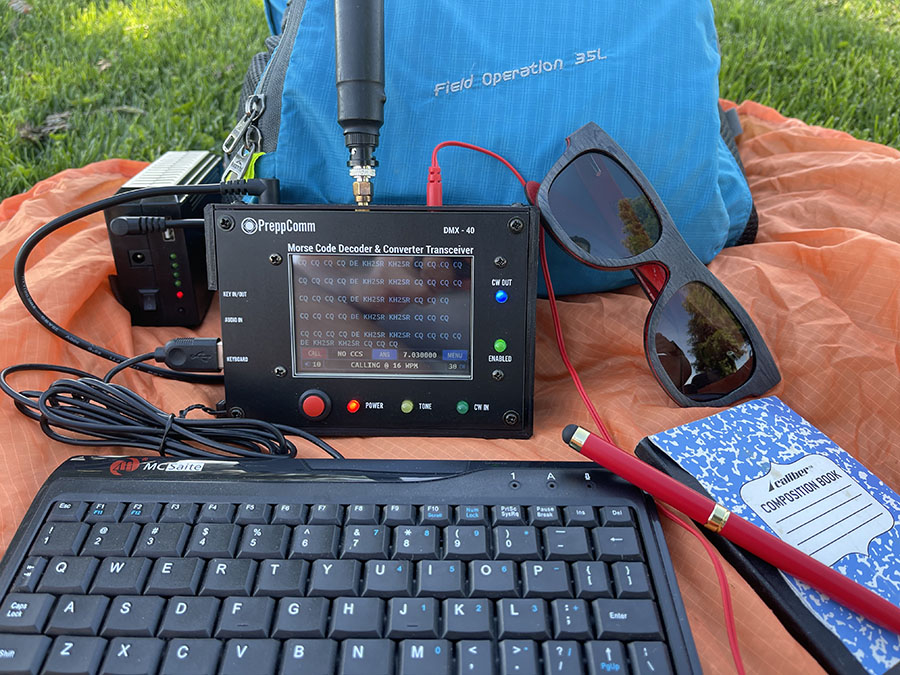
The DMX-40 eliminates a ton of barriers for beginners to start learning CW while making real QSO’s on the air before actually knowing any Morse code at all. With its built in touch screen setup guide, even a greenhorn technician class ham can easily get this rig on the air and making CW contacts in short order. Hams who purchased it without the intent to learn Morse code will likely inadvertently do so as they continue to listen to the incoming signals, watching the decoding take place, as well as hearing and seeing their own messages being encoded into CW as they type.
You may think that you have heard of these capabilities before, but nearly all the other software and hardware that claim this ability have major drawbacks (namely their inability to successfully decode when there is noise present, when the signal is weak, or when the ham sending isn’t hammering out his code perfectly). The DMX-40 handles all these difficulties with relative ease compared to the hardware and software competition.
In the past, I have used several different dedicated hardware CW decoders as well as a wide variety of software based CW decoders. The DMX-40 blows them all out of the water – both at being able to decode weak signals down in the noise, as well as its uncanny ability to differentiate between a wide variety of simultaneous signals during a pile up, all without getting confused.
In just a few short minutes after setup, I was on the air and decoding other hams QSO’s. Shortly after that, I was calling CQ and showing up on the reverse beacon network. This is all without reading the QuickStart guide reference manual too. There’s simply no need to immediately seek help online or desperately watch how to videos for assistance. To me, this was absolutely incredible! In my opinion, this makes the DMX-40 a game changer on multiple levels. Its ease of setup and use is second to none, and its impressive decoding and signal discrimination is quite possibly the best that has ever existed in a stand alone CW decoding ham radio product.
One of my favorite features is its ability to easily determine what speed at which the code is being sent. Its color coded bright LED lights indicate tone, CW in, CW out and edge of band. They are self explanatory and very effective at assisting operating the radio. I also really enjoyed having the type ahead buffer, which allows you to quickly correct what you’ve typed before it gets transmitted. Other great features include 10 frequency memories, automatic capturing of sent callsigns, and the various built-in micro programs and user customizable micro programs.
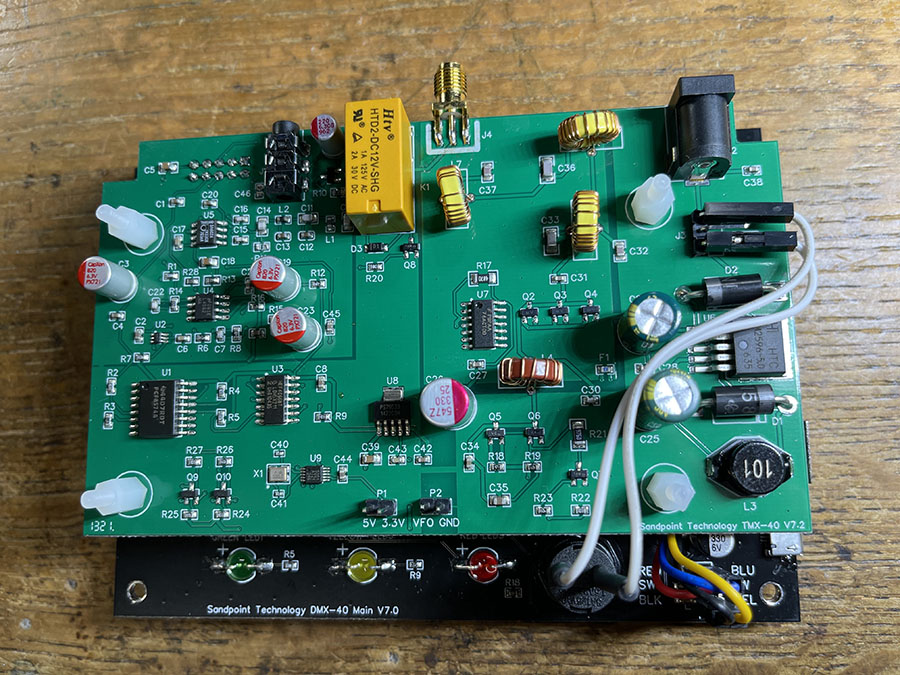
The transceiver utilizes 3D printing for about 75% of the enclosure and has a fairly sturdy build. Like many rigs, it is, however, in no way weather-resistant. This is easily remedied with the wide variety of waterproof cases on the market. I really like touch screen interface, but I wish more of the controls had the option to be utilized via the touch screen instead of just the keyboard (such as the volume control and frequency tuning). This isn’t really a problem with the rig as much as it’s just my personal preference. The LED indicators on the face of the radio are very helpful when tuning in a signal, and I especially like that the radio knows the band limits based on your license class. There is even a built-in help menu and keyboard interface guide in the settings page. The DMX-40 has a built-in 40m band HF CW transceiver with an RF power output of 4.5 watts when powered with 16 volts and 3 watts output when powered with 12 volts. However, the DMX-40 is not just limited to the 40m band.
If you’re like me, and you enjoy the flexibility of hopping around the various bands looking for activity, fear not. The DMX-40 is not stuck with only operating on the 40m band. It has the ability to switch into “external mode,” which allows you to connect to just about any other ham radio that has ports for headphone and morse code key. This means that you can quickly and easily utilize the DMX-40 on any ham band you want. I hooked the DMX-40 up to my Yaesu FT-991a and had a blast operating CW on a wide variety of HF bands. Just for fun, I also plan on connecting it to some of my other rigs including some pocket sized QRPp CW transceiver kits that I’ve built over the years.
On the rare occasion that I had trouble decoding incoming signals, nine times out of ten, the problem was between the keyboard and the chair (human error). I had either accidentally tuned off frequency, bumped some other key, or made some other simple bonehead mistake.
Overall, I’m very impressed with this amazing little lightweight black box of CW voodoo ham radio magic. If there was anything that could easily be improved upon, it would be including a smaller keyboard since the rig is designed to be portable. Also, a better option for leaning/ propping the radio at a 30-45 degree angle (such as built-in fold out feet or a compact stand of some kind). The 3D printed removable cover can be used for this, but I found it to be lacking when operating in the field with non flat surfaces. Another useful accessory is a dummy load to protect the rig from accidentally transmitting without an antenna connected I feel this is critical due to the lack of built in protection and that you can easily forget to change the rig to external mode when connecting to a separate transceiver. There are several small QRP dummy loads out on the market. I chose a micro sized variant that is barley bigger then the SMA connector it attaches to. I’ve included links to all these accessories at the end of the review.
One feature that I would like to see is user upgradable firmware. Currently, the only way to update the firmware would be to ship it back to PreppComm. As you can see in the photos, there is an unlabeled micro USB port on the side of the radio, so with any luck, this capability could potentially be added at a later time.
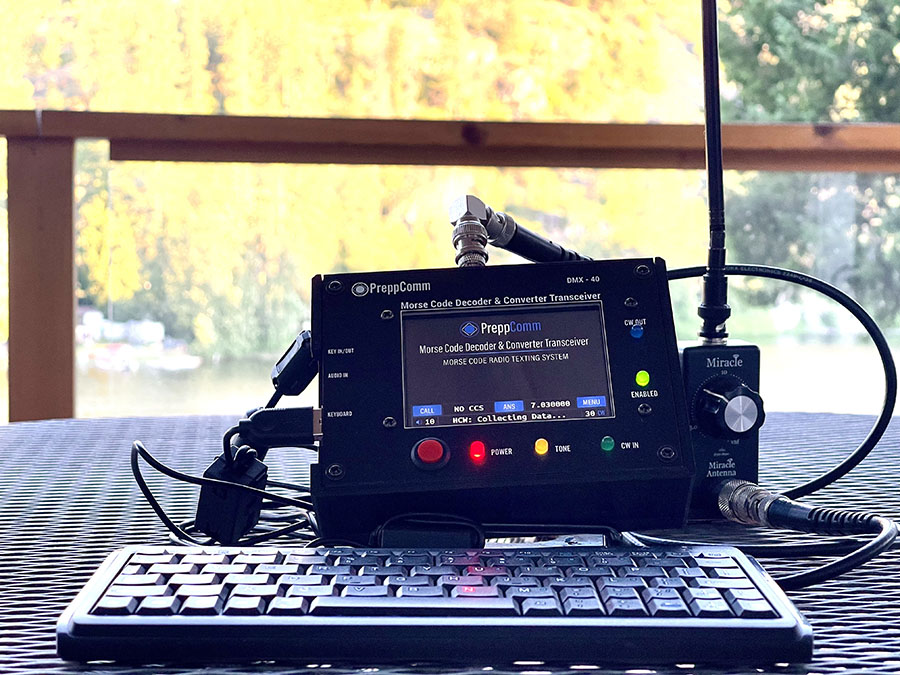
I happened to be in the Sandpoint, ID area on vacation, and Eric invited me over for an informal tour of his operations. He also was kind enough to walk me though some of the more advanced features of the device that I had not yet tested. His setup was impressive and we had a great time chatting about all things ham radio. He did hint at the potential for new products coming out down the road eventually but thats all I’m currently allowed to share at this time.
Eric also offers a couple different DMX-40 go-bag kit options that come with all kinds of accessories such as solar panels, lithium battery, go-bag sling pack, 40m antenna, waterproof cover and much much more.
I think the PreppComm DMX-40 has the potential to rejuvenate interest in morse code usage and could possibly ring in the beginning of a new golden era of CW operating. CW could even someday rival that of the evil scourge FT8 (just kidding about the “evil” part…. kinda) and return to its former glory of widespread use.
If you are a ham who just recently earned your ticket, or a long time no code ham, then this may finally be the right device to quickly get you on the air operating CW and with any luck, learning it as well. I highly recommend this product, and I look forward to seeing the positive impact it has on our beloved hobby.
73! James Hannibal – KH2SR
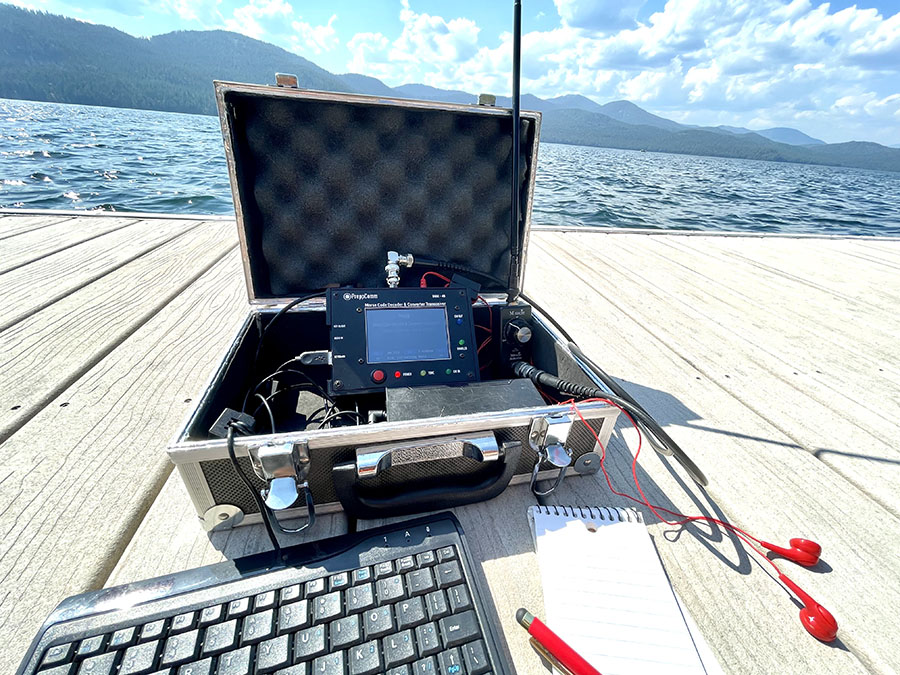
Designed and made in USA
Price: $349
For more information, visit the following links:
PreppComm Homepage: preppcomm.com/
Smaller Keyboard I prefer: amazon.com/dp/B07DZZWD9W
Adjustable Stand: amazon.com/dp/B017TU2WGS
Specifications:
• Advanced Direct Conversion SDR Receiver: with custom filter, balanced mixer, and low-noise preamp giving sensitivity ≈ 0.8µV
• GUI: 3.5″ color touchscreen LCD
• Weight: 11 oz with protective lid
• Size: 3.8″ x 5.2″ x (1.3″ w/o lid, 2.25″ w/lid)
• Power Consumption, receive: Approx. 1.4 watt, LCD backlight ON, approx. 0.96 watts with LCD backlight OFF.
• Power Consumption, transmit (average, 50% keydown): Approx. 3.4 watts at 12V input. Rises to 4.8 watts at 16V input (16V MAX)
• Power Output: Approx. 3 Watts at 12V input, Approx. 4.5 Watts at 16V input (16V MAX)
• Average Power, based on 25% transmit, LCD always on: 1.9 watts at 12V, 2.3 watts at 16V (16V MAX)
• Receive Tuning Range: 4.9 MHz to 10.2 MHz.
• Transmit Enabled Range: Extra Class: 7.0 MHz to 7.3 MHz, General Class: 7.025-7.125 MHz and 7.175-7.3 MHz, Technician Class: 7.025-7.125 MHz.
Features:
• Unparalleled Decoder Capability in Noisy Environments: With its unique signal processing algorithms, the Morse Code decoder outperforms all others.
• Type and Read in English: Use the included QWERTY keyboard to type while hearing outgoing and in incoming Morse Code, aiding in learning the code subconsciously.
• (Optional) Learn Morse Code: The included Morse Code Key-In capability with built-in decoder testing aids in learning the Code.
• Automated Send/Receive Protocols: Enter your call sign and other information for station setup. Remote station call sign captures automatically. All call and answer protocols are automatic – you only type your message. Or change the protocol via built-in micro-program editor.
• Set your maximum comfortable typing speed: While the DMX-40 can send very fast, it’s best to limit speed so you don’t starve the transmitter. A unique feature that maximizes the use of the type-ahead buffer in transmit mode calculates your comfortable typing speed automatically.
• Super Power Micro-programming System: Besides simple automating common text segments, the micro-programming system allows control over the transmitter, enabling many advanced features. 12 micro-programs up to 60 characters each.
• Captures station call signs automatically, so you don’t have to do it, or even remember the call sign for the required station ID’s. It’s done automatically for you!
• Protects you from transmitting on unlicensed frequencies within the 40 meter band, as well as outside it
• Built-in single keystroke INFO micro-program transmits the standard information commonly shared (name, location, rig, antenna). This information is entered for the local station in setup, including call letters, from the Main Menu
• Built-in Calling micro-program automates General Call (Calling CQ) and Directed Call (calling a specific station).
• Built-in Answer micro-program automates Validate-Answer (ensure there is a 2-way communication when answering) and standard back-and-forth communications, with all station ID’s automated.
• Pop-Up Type-Ahead Buffer allows up to 76 characters to be typed and edited ahead of the transmitter. Prevents starving the transmitter.
• Comfortable Typing Speed Test allows the capture of your typing speed, to be used to control the transmitter maximum transmit speed. Editable by the user, as well.
• Transmit Speed Throttle prevents transmitter from outpacing your typing speed.
• Provides a mechanism for measuring and applying your comfortable typing speed to the transmitter throttle, allowing you to keep ahead of the transmitter at all times.
• Ten Frequency Memories with custom 9 character labels accessible from the Menu System or keyboard shortcut.
• Frequency Memory Editor allows the user multiple ways to specify a frequency, as well as a label for the defined frequency.
• Touchable Frequency Memory List, showing all 10 frequency memories in one place. Frequencies can be selected simply by touching their entries, or edited by touching the associated EDIT button.
• Frequency Memories List is accessible from the Main Menu, or via a keyboard shortcut.
• Extended Range Receiver tunes from 4.9 MHz to 10.2 MHz, covering many shortwave bands, as well as 5.0 MHz and 10.0 MHz WWV atomic clock frequency stations.
• Receiver Incremental Tuning (RIT) after transmitting, allows user to make fine adjustments without changing transmit frequency.
• Twelve User-Defined Micro-Programs that can be either be often sent text or transmitter control, or a combination of transmitter control and text
• Powerful Micro-Program Language RPL (Rig Programming Language) allows many powerful functions to be implemented, allowing user redesign of the operation of the transceiver CALL and ANS functions, focus on contests, message station repeating a message at programmed intervals, and much more.
• Microprogram Editor allows full text edit of up to 60 characters per micro-program. Micro-program Help Screens directly available from the Editor.
• Touchable Micro-Program Lists: All micro-programs are listed on 3 screens, and can be executed by touch, or edited by touching the associated EDIT button. The Microprogram List screens can be accessed from the Main Menu or a shortcut key.
• Upgrade Existing Transceivers to Full Morse Code Capability by connecting to the AUDIO-IN and KEY-OUT connections and switching to External Mode. This eliminates the 40 meter band limitation of the DMX-40.
• Full Keyboard Control: 18+ keyboard commands plus 44 frequency memory and microprogram edit and execute keys provide full control of most functions from the keyboard
• Transmit Speed Automatically Set based on received frequency to match the other stations speed capability, and user speed throttle when local user typing speed is slower, for smooth communications
• Single Keystroke Default Transmit Speed for first outgoing call. Alternatively, a different value can be keyed in, and the value can be optionally set as the new default.
• Power Saving auto LCD Backlight Shut-Off after 3 minutes of no activity to conserve battery power. Single key restores backlight.
• Extensive Help Menus for microprogramming, and transmit and receive keyboard commands.
• User Accessible VFO Calibration via WWV Signal. Every DMX-40 is factory calibrated to WWV to within a few Hz, and thus should not require recalibration for at least several years.
• Large, Easy to Read color-coded LCD Text for incoming and outgoing text, transceiver status, and type-ahead buffer.




